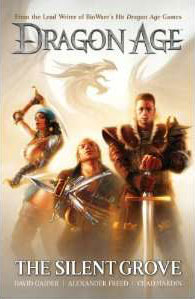
Additional information and cover images available for some titles; click on marked items or or Collapse All.
Projects not yet officially announced will not be listed here. Prospective business partners may contact me directly for more up-to-date information and references from current clients.
Video Games:
- Multiple Unannounced Products
- Battlefield 2042 (EA DICE / Electronic Arts, 2021)
- Wasteland 3 (inXile Entertainment, 2020)
I had the privilege to make some small-scale narrative design contributions early during this project’s development. Working on such a storied and influential franchise was grand, as was collaborating with the inXile crew.
- Storyscape (Fogbank Entertainment / FoxNext Games, 2019)
- Anthem (BioWare / Electronic Arts, 2019)
- Star Wars Battlefront II (EA DICE / Electronic Arts, 2017)
No one likes writing “barks”–those one-line utterances that characters shout in the middle of action sequences, often ignored by players and repeated over and over again across the course of a game. (“Over here!” “I’m hit!”) But combat barks are vital for evoking a sense of life on the battlefield. If done well, they can add surprising humor and pathos to a game of multiplayer combat; if done poorly, they become obtrusive, repetitive, and out-of-place.When I came aboard to take on some of Battlefront II‘s bark writing, I had low expectations–it looked like a fun project and I had an opening in my schedule, yet I generally prefer to focus on more story-oriented content. I intended to produce the best work I could (barks are surprisingly difficult to do well–a subject for another time) but I was pleasantly shocked by the amount of love and care the DICE team put into this particular form of storytelling. I spent time with the team in Sweden discussing every particular we could dream up, and worked closely with them to try and make the dialogue anything but obtrusive, repetitive, and out-of-place. I wrote thousands of lines, ranging from absurd droid dialogue to mission narration to heroic entrances.
It’s never going to be the first thing I point to as a great example of the sort of writing I do, but I’m proud to have been part of the team and pleased with what we accomplished.
- Mass Effect: Andromeda (BioWare / Electronic Arts, 2017)
My contributions to Mass Effect: Andromeda were ultimately trivial–I lent the team a helping hand for a month during my longer tenure on Anthem, taking on odd jobs and supporting the permanent writing staff. Nonetheless, I think very fondly of the experience–I got to work with several old colleagues I hadn’t collaborated with in some time and spend my days in beautiful Montreal. Well worth the effort.
- Tyranny (Obsidian Entertainment, 2016)
Tyranny is a fantasy role-playing game from RPG stalwart Obsidian Entertainment–a company with a choice-and-branching pedigree quite similar to BioWare’s. I served as an editorial consultant for this project, and enjoyed the opportunity to aid the writing team in that role; it’s always hard for me to turn down a chance to analyze and critique branching narrative.
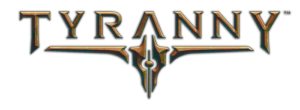
- The Banner Saga 2 (Stoic, 2016)
As with Tyranny (above), The Banner Saga 2 is another branching dialogue-based fantasy role-playing game I had the pleasure of consulting on. I provided editorial notes and feedback on both early plot documents and completed story sequences, offering what wisdom I could to ensure the product met its quality goals.
- Star Wars: The Old Republic – Knights of the Fallen Empire (BioWare / Electronic Arts, 2015)
- Star Wars: Uprising (Kabam, 2015)
- Shuyan Saga (Lofty Sky Entertainment Inc, 2017)
I served as an editorial consultant on this action game, advising on plot and characters and reviewing branching dialogue sequences delivered by the writing team. As a freelancer, I rarely get the pleasure of playing editor; this was a chance to exercise little-used muscles and work with some talented people.
- Shadow Realms (BioWare / Electronic Arts, cancelled)
A planned free-to-play multiplayer action RPG, Shadow Realms was to be BioWare Austin’s second game (following Star Wars: The Old Republic). I was Lead Writer during the earliest days of the project, working to formulate initial ideas for the intellectual property, the game narrative, and the game design. When I left the company it went into very capable hands, but–despite being publicly announced and shown at trade shows–the project was, alas, cancelled in 2015.
- Star Wars: The Old Republic - Shadow of Revan (BioWare / Electronic Arts, 2014)
I planned and wrote a portion of the content of the fourth “digital expansion” for Star Wars: The Old Republic as a freelancer. Specifically, I was responsible for the eight new “class story” missions, revisiting the themes and characters of the original game’s Player class storylines. I also wrote minor miscellaneous content (such as “light” side quests and barks).
- Star Wars: The Old Republic - Galactic Starfighter (BioWare / Electronic Arts, 2014)
The second “digital expansion” for Star Wars: The Old Republic introduces a new player-versus-player spaceflight component. I wrote additional content as a freelancer (including companion character dialogue and “technical specs” for ships and components).
Although not officially part of the expansion, I also wrote content for the planet Oricon, added to the game between the first two expansions.
- KingsRoad (Rumble Entertainment, 2013)
I was brought on board during the later stages of KingsRoad’s development to rewrite dialogue and streamline the story for this free-to-play action role-playing game. I also had the opportunity to plot out additional chapters of story content.
KingsRoad is playable through a web browser at no cost. See the website for details.
- Star Wars: The Old Republic - Rise of the Hutt Cartel (BioWare / Electronic Arts, 2013)
The first “digital expansion” for Star Wars: The Old Republic continues the game’s storyline and introduces the planet Makeb. I served as Lead Writer during much of this expansion’s development and, in addition to overseeing the writing team during that time, had the privilege of writing a substantial amount of content myself (primarily focused on the Makeb Imperial faction storyline).
This expansion is also notable for introducing some of the first LGBT characters in the Star Wars universe, and while some fans criticized the addition as “too little, too late” (while others decried such additions altogether), I was very pleased to have had a part in adding diversity to a mass market franchise that, in truth, has always been unfortunately homogenous.
- Star Wars: The Old Republic (BioWare / Electronic Arts, 2011)
The largest project I’ve ever worked on–and very likely, the largest project I ever will work on, due to its unprecedented scope. This massively multiplayer online role-playing game is set several thousand years before the Star Wars films and allows players to take on the roles of eight different character types (classes) serving either the democratic Galactic Republic or the tyrannical Sith Empire. Each of the eight character classes has a unique storyline with as much quest and conversation content as a complete single-player game (a la BioWare’s Mass Effect). In addition, the game contains vast amounts of non-class specific story content that can be played solo or in groups.
Star Wars: The Old Republic was my first video game, and I could hardly have asked for a better initiation into the industry. For over half a decade, I designed areas, branching storylines, and quests; wrote interactive dialogue; and helped manage a team of over a dozen writers under the brilliant Daniel Erickson. By the time the game launched in December 2011, I had written the complete “Imperial Agent” class storyline (along with large amounts of non-class-specific content) and been promoted to Lead Writer myself.
The game launched to favorable reviews and easily surpassed subscription numbers for any other game of its type aside from the market leader, World of Warcraft. The game won four Game Developer’s Choice Awards, was selected as MSNBC’s Game of the Year for 2011, and is the Guinness World Record holder for Largest Entertainment Voice Over Project. Despite all this, the game eventually switched to a free-to-play model (by which time I had already worked with the team to develop post-launch content–see “Rise of the Hutt Cartel”–and moved on to other projects).
Of course the game has its flaws, as does the story–I certainly wouldn’t deny that. Nonetheless, I am immensely proud to have worked on the game and been part of such a terrifically talented team. This early review from PC Gamer covers much of my own work and represents, I think, the best of the critical reaction. Now and then, I still hear feedback from fans and am enormously gratified to have helped create something that touched so many people.
Novels:
- Star Wars: Victory’s Price (Del Rey, 2021)
- Star Wars: Shadow Fall (Del Rey, 2020)
- Star Wars: Alphabet Squadron (Del Rey, 2019)
- Rogue One: A Star Wars Story (Del Rey, 2016)
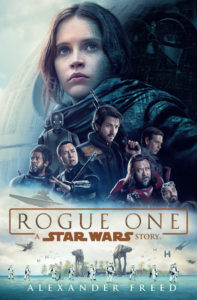 A novelization of the film by John Knoll, Gary Whitta, Chris Weitz, and Tony Gilroy, Rogue One: A Star Wars Story was a strange and wonderful project, in its way–I’d written stories off other people’s outlines before (in comics and games), but I’d never done a full-on adaptation. I was lucky to have enormous support from Del Rey and Lucasfilm, however–I was given great leeway to add new scenes and supplementary material, as well as to dig into the internal states of the characters. From the start, my hope was to make a book that “justified its own existence” (as I discuss at length in this interview).
A novelization of the film by John Knoll, Gary Whitta, Chris Weitz, and Tony Gilroy, Rogue One: A Star Wars Story was a strange and wonderful project, in its way–I’d written stories off other people’s outlines before (in comics and games), but I’d never done a full-on adaptation. I was lucky to have enormous support from Del Rey and Lucasfilm, however–I was given great leeway to add new scenes and supplementary material, as well as to dig into the internal states of the characters. From the start, my hope was to make a book that “justified its own existence” (as I discuss at length in this interview).The critical and fan reception was largely positive. The book spent several weeks on the New York Times best seller list for hardcover fiction, and the New York Daily News noted that “Freed’s writing style … works perfectly,” and “Even more than the movie, the novelization of ‘Rogue One’ offers an intimate look at the suffering and moral compromises of those touched by this galactic war.” Entertainment Earth called it “without doubt, the best film novelization I have ever read,” and fansite Tosche Station declared “Alexander Freed’s novelization works so harmoniously with Garth Edward’s film that they feel like two halves of a whole,” and “Buy it. Let it break your heart a little more.”
Originally, the hope had been to make the novelization a full collaboration between myself and screenwriter Gary Whitta. Alas, the scheduling particulars turned out to be unworkable, but Gary was nonetheless immensely helpful and I owe him a special debt of gratitude.
- Star Wars: Battlefront: Twilight Company (Del Rey, 2015)
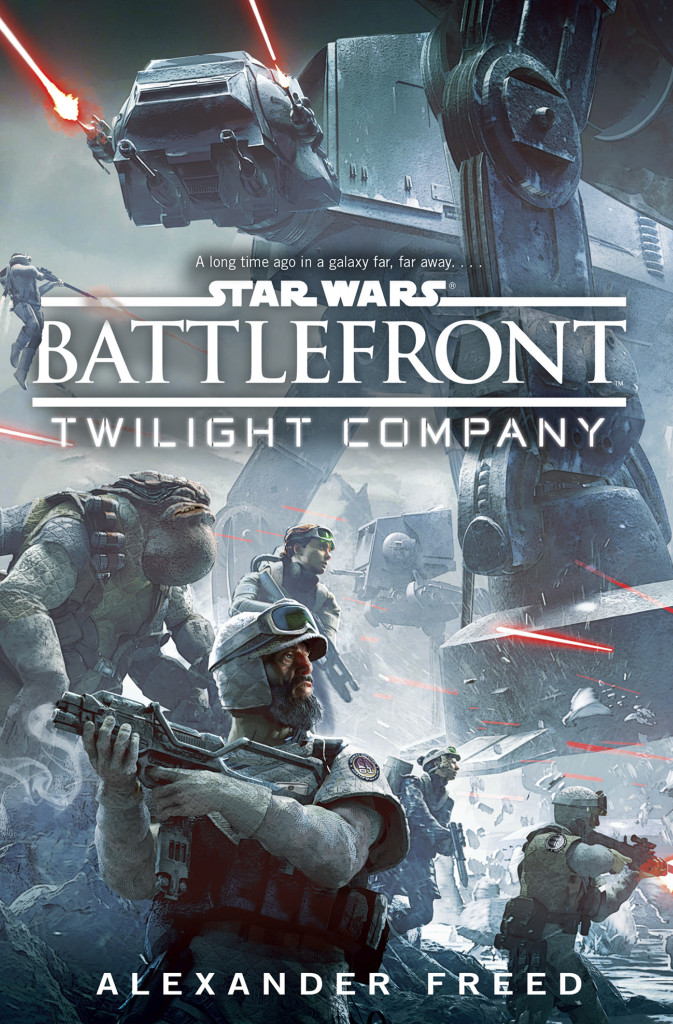 A “companion novel” to the multiplayer video game Star Wars: Battlefront, Twilight Company is not a tie-in in the traditional sense; it’s an original story featuring a new cast of characters in the Star Wars universe that utilizes locations, equipment, themes, and so forth featured in the game.
A “companion novel” to the multiplayer video game Star Wars: Battlefront, Twilight Company is not a tie-in in the traditional sense; it’s an original story featuring a new cast of characters in the Star Wars universe that utilizes locations, equipment, themes, and so forth featured in the game.Twilight Company was my first published novel and has been generally well received: BuzzFeed included it in its “Best Science Fiction Books Of 2015” list, while the New York Daily News says it “effortlessly thrusts readers onto the frontlines of the Galactic Civil War in a gripping tale,” and that “[a] novel that ties in to a video game based on a sprawling sci-fi franchise shouldn’t be this good.” Alternative Nation called it “a darker and more personal tale” and “easily the strongest canon piece of Star Wars literature thus far.” Dedicated Star Wars fan sites seemed broadly supportive as well, with Eleven-ThirtyEight declaring “So if you are still on the fence, buy this book. Even if you don’t care about videogames. Even if military sci-fi is not your cup of tea. Because Star Wars Battlefront: Twilight Company is not about war: it’s about people.”
I remain very grateful to Del Rey editors Shelly Shapiro and Frank Parisi for taking a chance on me with this project–I can’t imagine why anyone decided it was wise to toss a time-sensitive novel over to someone who’d never published one before, but it seems to have worked out relatively well.
Comic Books:
- Violet Dawn: Exile (WayWalker Studios, 2022)
- Assassin’s Creed: Forgotten Myths (Dark Horse Comics, 2022)
- Anthem (Dark Horse Comics, 2019)
- Dragon Age: Until We Sleep #1-3 (Dark Horse Comics, 2013)
- Star Wars: Purge - The Tyrant's Fist #1-2 (Dark Horse Comics, 2013)
This two-issue miniseries is a thematic sequel to previous Star Wars: Purge one-shots. The series was drawn by Marco Castiello and Andrea Chella, colored by Michael Atiyeh, lettered by Michael Heisler, and edited by Dave Marshall. The cover art was created by Dan Scott.
The series tells the story of Darth Vader’s quest to slay the last of the Jedi after the events of the Star Wars prequels, and to change the culture of the newly formed Galactic Empire. I wrote about creating the series at the Dark Horse Comics blog.
Cover images are courtesy of the Grand Comics Database, which is licensed under the Creative Commons Attribution 3.0 Unported license.
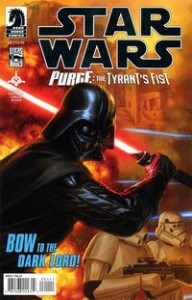
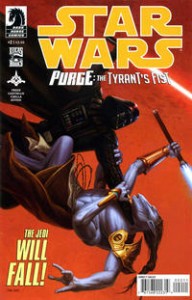
- Dragon Age: Those Who Speak #1-3 (Dark Horse Comics, 2012)
- Dragon Age: The Silent Grove #1-6 (Dark Horse Comics, 2012)
The first of three comic series co-written by David Gaider (who provided plots) and myself (on scripts) tying into the Dragon Age video game franchise. As Lead Writer of the franchise and author of several Dragon Age novels, David Gaider was the natural choice as the series “vision holder”–I wrote a bit about our collaborative process here.
All three series star familiar characters from the game: Alistair Theirin, Varric Tethras, and Isabela. The Silent Grove focuses on Alistair as he seeks the answer to a question with profound political and personal repercussions. He travels with his companions to distant Antiva, encounters an order of assassins, and faces off against magic. And of course there’s a dragon.
The Silent Grove was originally released as six twelve-page digital-format issues before later being collected in hardcover. I found my experience working on the seven-page Star Wars: The Old Republic comics to be a substantial aid when pacing these short, serialized episodes. Chad Hardin provided the series art, Michael Atiyeh provided colors, Michael Heisler was responsible for lettering, and Dave Marshall was our editor. Anthony Palumbo was the series cover artist.
- Star Wars: The Old Republic - The Lost Suns #1-5 (Dark Horse Comics, 2011)
This series, as with the “Blood of the Empire” storyline (see below) ties into the Star Wars: The Old Republic video game. Specifically, it tells a story that parallels the game’s main story, connecting and weaving through multiple elements vital to the game’s fiction.
The Lost Suns introduces the character of Theron Shan, the non-Force sensitive child of a Jedi Master; Theron (alongside another character created for The Lost Suns) was later used as the protagonist in Drew Karpyshyn’s novel Star Wars: The Old Republic – Annihilation.
Dave Ross, George Freeman, and David Daza provided pencils for the series, with Mark McKenna on inks and Michael Atiyeh on colors. Lettering by Michael Heisler. The covers are by Benjamin Carré. Dave Marshall was our editor.
Cover images are courtesy of the Grand Comics Database, which is licensed under the Creative Commons Attribution 3.0 Unported license.
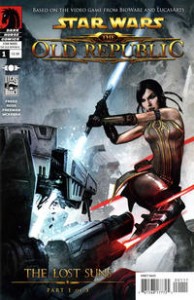
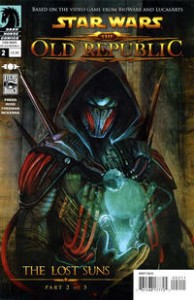
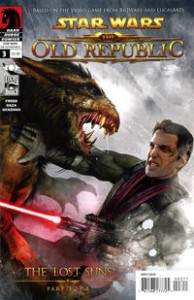
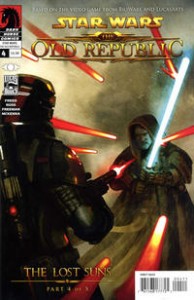
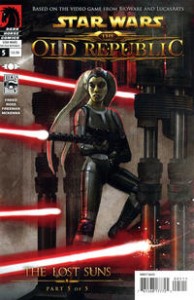
- Star Wars: The Old Republic #4-6 (Dark Horse Comics, 2010)
Originally distributed as twelve seven-page digital issues on the Star Wars: The Old Republic website, this series was later reprinted in comic form as well as in a collected edition entitled Star Wars: The Old Republic Volume 1 – Blood of the Empire. In order to familiarize myself with how to pace a serialized narrative in episodes of only seven pages each (substantially shorter than the typical American comic), I spent some time reading and researching weekly comics like the British anthology 2000 AD.
This was my first published comic work, a direct tie-in to the Star Wars: The Old Republic video game, and I remain grateful to BioWare and Dark Horse Comics (in particular, BioWare Creative Director James Ohlen and Dark Horse Editor Dave Marshall) for taking a chance on me. The comic’s pencils are by Dave Ross, with inks by Mark McKenna, colors by Michael Atiyeh, and lettering by Michael Heisler. The covers are by Benjamin Carré.
The story concerns a young Sith apprentice and his struggle to prove himself in an Empire that considers him lacking. He is offered a chance to redeem himself in a mission concerning the secret goals of the mysterious Emperor, and he must decide what he truly values in life.
Cover images are courtesy of the Grand Comics Database, which is licensed under the Creative Commons Attribution 3.0 Unported license.
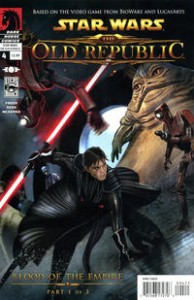
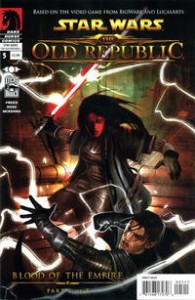
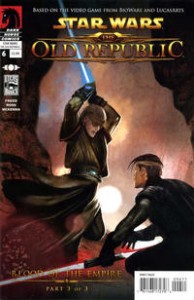
Short Fiction:
- The Man Who Built Cloud City (From a Certain Point of View: The Empire Strikes Back, Del Rey, 2020)
- Contingency Plan (Star Wars: From A Certain Point of View, Del Rey, 2017)
- Ten Confessions of Blue Mercury Addicts, by Anna Spencer (Interzone #263, TTA Press, March 2016)
- The End of History (Star Wars Insider #154, Titan Magazines, 2014)
- One Thousand Levels Down (Star Wars Insider #151, Titan Magazines, 2014)
- The Last Battle of Colonel Jace Malcom (Star Wars Insider #128, Titan Magazines, 2012)
This short story takes place in the Star Wars universe. It is set after the events of the initial Star Wars: The Old Republic video game storyline and sets the stage for Drew Karpyshyn’s novel Star Wars: The Old Republic – Annihilation (which in turn used characters created for my Star Wars: The Old Republic – The Lost Suns comic series).
“The Last Battle of Colonel Jace Malcom” was an interesting challenge, and my first chance at Star Wars prose fiction. Devoted fans may know the protagonist from the video game’s Hope trailer.
- The Shenu (Interzone #219, TTA Press, 2008)
In the January 2009 issue of Locus magazine, reviewer Rich Horton described this short story thusly:
“I also enjoyed Alexander Marsh Freed‘s ‘The Shenu‘, a fairly pure urban fantasy about Markos, who is convinced he can do magic, particularly putting his soul–or, in Egyptian terms, his ren–in a stone. The story is not so much interested in the magic than in Markos’s ordinary city life, his girlfriend Isabel, his other friend Pedro, and the various magical aspects–or not–of their interactions.”
It seems as good a description as any, and I was pleased to once again publish in the venerable British SF magazine Interzone.
- The Star Necromancers (Interzone #208, TTA Press, 2007)
- Lady Vitoria’s Mind (Robots and Time, Altair Australia, 2006)
- Mirror, Rust, and Dark (Path of the Just, Guardians of Order, 2003)
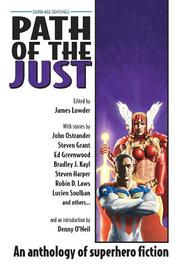
This short story appeared in Path of the Just, an anthology of superhero fiction set in the Silver Age Sentinels role-playing universe. The anthology was edited by James Lowder and contains prose fiction from regular comic book writers John Ostrander (a personal favorite of mine) and Steven Grant, as well as a host of other talented authors.
My story “Mirror, Rust, and Dark” deals with the trauma and ultimate fallout of a young woman’s visit to an evil parallel universe. As with a number of stories in the anthology, it explores life in a superhero universe through the lens of a not-quite-superheroic protagonist.
Cover courtesy OpenLibrary.org.
- Inheriting Red (The Book of More Flesh, Eden Studios, 2002)
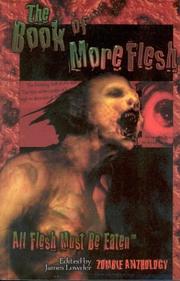 This short story originally appeared in The Book of More Flesh, an anthology of zombie fiction (the second of three such anthologies edited by James Lowder–the others were The Book of All Flesh and The Book of Final Flesh). This anthology was nominated for a 2002 International Horror Guild Award and was a finalist for a 2002 Origins Award.
This short story originally appeared in The Book of More Flesh, an anthology of zombie fiction (the second of three such anthologies edited by James Lowder–the others were The Book of All Flesh and The Book of Final Flesh). This anthology was nominated for a 2002 International Horror Guild Award and was a finalist for a 2002 Origins Award.My contribution, “Inheriting Red,” deals with the intelligence at the center of a zombie horde, and the apparently messianic purpose behind the zombies’ wrath. It is one of my exceedingly rare ventures into genre horror (and despite the zombie trappings, it may still not qualify).
Cover courtesy OpenLibrary.org.
Role-Playing Games:
- Astral Realms (White Wolf Publishing, 2007)
- Intruders: Encounters With the Abyss (White Wolf Publishing, 2007)
- Secrets of the Ruined Temple (White Wolf Publishing, 2006)
- Lorebook of the Broken Isles (The Inner Circle, 2006) (e-book)
- Player’s Guide to the Broken Isles (The Inner Circle, 2006) (e-book)
- eco (Morrigan Press, 2006)
- Talislanta Menagerie (Morrigan Press, 2006)
- Fantasy Personae: Sages, Spies, and Informants (The Inner Circle, 2005) (e-book)
- Hungry Little Monsters (Sean K Reynolds Games, 2006) (e-book; as editor)
- Monte Cook Presents: The Year’s Best d20 (White Wolf Publishing, 2005) (reprint)
- Strange Lands: Lost Tribes of the Scarred Lands (White Wolf Publishing, 2004)
- Arms & Armor (Bastion Press, 2004)
- The World’s Largest Dungeon (Alderac Entertainment Group, 2004) (as editor)
- Legends of Avadnu (The Inner Circle, 2004) (e-book)
- Denizens of Avadnu (The Inner Circle, 2004)
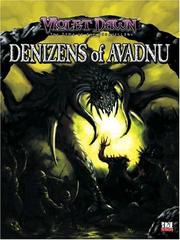 One of my first experiences working on a large-scale role-playing game book, the Inner Circle’s Denizens of Avadnu was a bestiary for the Violet Dawn campaign setting running on d20 System (essentially Dungeons & Dragons-compatible) rules. I wrote a substantial portion of the book’s contents (both the fiction and game mechanics) and edited the rest.Since the Inner Circle was founded primarily by artists, we very often created monsters to match existing illustrations, rather than commissioning illustrations to suit a writeup (though that was done as well). While this could occasionally prove difficult, it ultimately served well to keep the team energized and creatively engaged. The book went on to be nominated for a Gen Con EN World RPG Award (for Best d20 Monster Supplement) and was excerpted in Monte Cook Presents: The Year’s Best d20. It had a number of later e-book incarnations–the Digital Denizens series collected portions of the book in smaller segments and The Complete Book of Denizens added the creatures from Legends of Avadnu and other Inner Circle products to the original.This was far from the last time I would work on a monster book, and I ultimately developed a moderately elaborate philosophy of monster creation. While these skills mostly lie dormant nowadays, every now and then I find them unexpectedly useful. I have also continued to collaborate with the talented members of the Inner Circle over the years; Jeffrey Visgaitis–writer, artist, and project manager for Denizens–designed this very website.Cover courtesy OpenLibrary.org.
One of my first experiences working on a large-scale role-playing game book, the Inner Circle’s Denizens of Avadnu was a bestiary for the Violet Dawn campaign setting running on d20 System (essentially Dungeons & Dragons-compatible) rules. I wrote a substantial portion of the book’s contents (both the fiction and game mechanics) and edited the rest.Since the Inner Circle was founded primarily by artists, we very often created monsters to match existing illustrations, rather than commissioning illustrations to suit a writeup (though that was done as well). While this could occasionally prove difficult, it ultimately served well to keep the team energized and creatively engaged. The book went on to be nominated for a Gen Con EN World RPG Award (for Best d20 Monster Supplement) and was excerpted in Monte Cook Presents: The Year’s Best d20. It had a number of later e-book incarnations–the Digital Denizens series collected portions of the book in smaller segments and The Complete Book of Denizens added the creatures from Legends of Avadnu and other Inner Circle products to the original.This was far from the last time I would work on a monster book, and I ultimately developed a moderately elaborate philosophy of monster creation. While these skills mostly lie dormant nowadays, every now and then I find them unexpectedly useful. I have also continued to collaborate with the talented members of the Inner Circle over the years; Jeffrey Visgaitis–writer, artist, and project manager for Denizens–designed this very website.Cover courtesy OpenLibrary.org.
- Toxic Memes (Steve Jackson Games, 2004)
- Tribe 8 2nd Edition Player’s Handbook (Dream Pod 9, 2004)
- Complete Minions (Bastion Press, 2003) (e-book)

